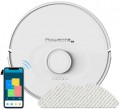Suction force
The suction force provided by the vacuum cleaner. It is indicated by the maximum vacuum (negative pressure) that the unit can create at the working nozzle.
Note that this parameter is sometimes confused with the suction power described above, which is indicated in watts. Yes, suction force to some extent determines the efficiency of the unit. However, this efficiency also depends on the performance (airflow). And the suction power, indicated in watts, takes into account both of these parameters — it is determined by multiplying the suction force by the performance (see above for more details). For this reason, there is no strict relationship between this force and suction power: for example, a vacuum of 25,000 Pa can be found in models with 250 W, 200 W and even 150 W of power.
As for the practical significance of this spec, in general, a higher suction force allows you to work more efficiently with high resistance. For example, when processing carpets with a long pile. On the other hand, more pascals (with the same number of watts) means less airflow and, accordingly, less efficiency for large amounts of work at low resistance (for example, cleaning large rooms with parquet floors). Thus, it makes sense to pay attention to this indicator mainly in cases where high suction force is fundamental for you. In other cases, it is worth evaluating the capabilities of the vacuum cleaner in terms of suction power in watts.
Note that for a number of
...reasons, the suction power is most often specified for robot vacuum cleaners (see “Produc type”). For such models, a value of 1500 Pa and below is considered very small, 1500 – 2000 Pa — medium, 2000 – 2500 Pa — high, more than 2500 Pa — very high.
It is also worth mentioning that the indication of suction force is often used as a publicity trick — to improve the impression of the product. For example, the suction power of 150 watts in itself is quite modest. But at the same time, the suction force of such a vacuum cleaner can be 25,000 Pa — a very impressive figure, especially for an inexperienced buyer, but having a very indirect relation to real efficiency. Especially often, such tricks are used among upright models and the already mentioned robots — these varieties initially do not differ in high power in watts. For many of these units, the characteristics only indicate the vacuum in pascals without specifying the suction power. It further enhances the impression: for example, in the specs of a modest robot, the figure "3000 Pa" looks much more impressive than "40 W". However, such figures have a very weak relation to the real capabilities of the unit and if they are not supplemented by data on suction power in watts, they should be considered solely as bait for a not particularly sophisticated buyer.Dust collector capacity
The nominal volume of the dust collector installed in the vacuum cleaner.
This indicator largely depends on the type of unit (see above). For example, in most handheld household models, the capacity
does not exceed 0.5 L. The volume of the container in upright vacuum cleaners and robots can be somewhat larger — among the first variety there are quite a few models for
1 – 2 liters or even more, and among the second — by
0.6 – 1 liter and a little more. For conventional vacuum cleaners, the minimum figure is actually about 0.8 – 1 L; dust collectors for 1 – 2 L and
2 – 4 L are very popular in such devices; the maximum capacity is actually
4 – 6 liters — units of a similar layout, but with a larger capacity, are usually referred to as household ones. In turn, relatively small containers are occasionally found among workshop models. However, in vacuum cleaners of this type, the capacity is generally quite large — it can reach
26 – 50 liters or even
more ; the same applies to industrial (construction) units.
In general, a larger dust container allows you to work longer without interruptions. On the other hand, a capacious container itself takes up more space and, accordingly, affects the size, weight and price. So when choosing th
...is parameter, it is worth considering the actual features of the use of a vacuum cleaner. Here we can give such an example: for a full-scale cleaning of an average city apartment, a capacity of about 1 – 1.5 litres is required. Thus, say, a 4-litre bag allows you to carry out two such cleanings with sufficient efficiency without unloading the vacuum cleaner. There are more detailed recommendations regarding the optimal volume of the dust collector, including specific cleaning options. These recommendations can be found in special sources.Battery capacity
The capacity of the battery installed in the vacuum cleaner.
Recall that batteries are used in all robots, as well as other types of vacuum cleaners for which mobility is important; see "Power supply" for details. As for battery capacity, theoretically, a larger battery allows you to work longer without recharging. However, there are nuances. Firstly, the actual battery life of the unit will also depend on its type, power and some features of the functionality. Secondly, the actual battery capacity is determined not only by this indicator but also by the voltage in volts. So if these batteries differ in voltage, you need to convert their capacity into watt-hours and use this data when comparing. These calculations are described in more detail in special sources.
In light of all this, only vacuum cleaners with similar specifications can be directly compared in terms of battery capacity. And it is best to evaluate the actual battery life by the directly claimed operating time.

